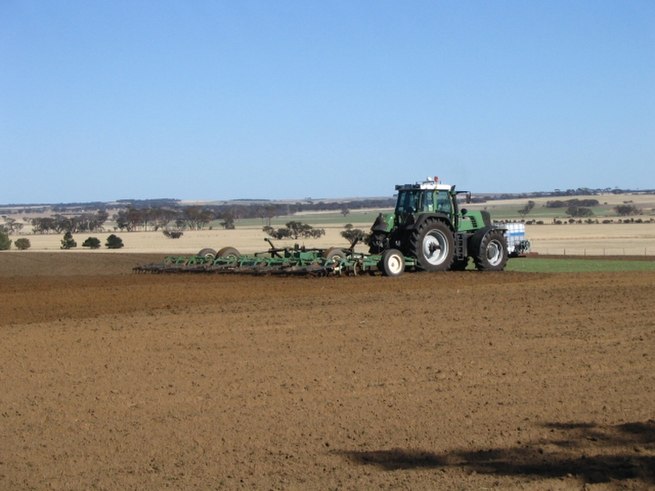
-
Tillage
Tillage is the agricultural preparation of soil by mechanical agitation of various types, such as digging, stirring, and overturning. Examples of human-powered tilling methods using hand tools include shovelling, picking, mattock work, hoeing, and raking. Examples of draft-animal-powered or mechanized work include ploughing (overturning with moldboards or chiseling with chisel shanks), rototilling, rolling with cultipackers or other rollers, harrowing, and cultivating with cultivator shanks (teeth). Small-scale gardening and farming, for household food production or small business production, tends to use the smaller-scale methods, whereas medium- to large-scale farming tends to use the larger-scale methods.
Tillage that is deeper and more thorough is classified as primary, and tillage that is shallower and sometimes more selective of location is secondary. Primary tillage such as ploughing tends to produce a rough surface finish, whereas secondary tillage tends to produce a smoother surface finish, such as that required to make a good seedbed for many crops. Harrowing and rototilling often combine primary and secondary tillage into one operation.
“Tillage” can also mean the land that is tilled. The word “cultivation” has several senses that overlap substantially with those of “tillage”. In a general context, both can refer to agriculture. Within agriculture, both can refer to any kind of soil agitation. Additionally, “cultivation” or “cultivating” may refer to an even narrower sense of shallow, selective secondary tillage of row crop fields that kills weeds while sparing the crop plants.
-
Tilth
Soil tilth is its physical condition of soil, especially in relation to its suitability for planting or growing a crop. Factors that determine tilth include the formation and stability of aggregated soil particles, moisture content, degree of aeration, rate of water infiltration and drainage. Tilth can change rapidly, depending on environmental factors such as changes in moisture, tillage and soil amendments. The objective of tillage (mechanical manipulation of the soil) is to improve tilth, thereby increasing crop production; in the long term, however, conventional tillage, especially plowing, often has the opposite effect, causing the soil to break down and become compacted. Soil with good tilth has large pore spaces for air infiltration and water movement. Roots only grow where the soil tilth allows for adequate levels of soil oxygen. Such soil also holds a reasonable supply of water and nutrients.Tillage, organic matter amendments, fertilization and irrigation can each improve tilth, but when used excessively, can have the opposite effect. Crop rotation and cover crops can positively impact tilth. A combined approach can produce the greatest improvement.
-
Tillage (noun)
the cultivation of arable land by plowing, sowing and raising crops
-
Tillage (noun)
land that has been so cultivated
-
Tilth (noun)
Agricultural labour; husbandry.
-
Tilth (noun)
The state of being tilled, or prepared for a crop; culture.
“The land is in good tilth and ready to plant.”
-
Tilth (noun)
Rich cultivated soil.
